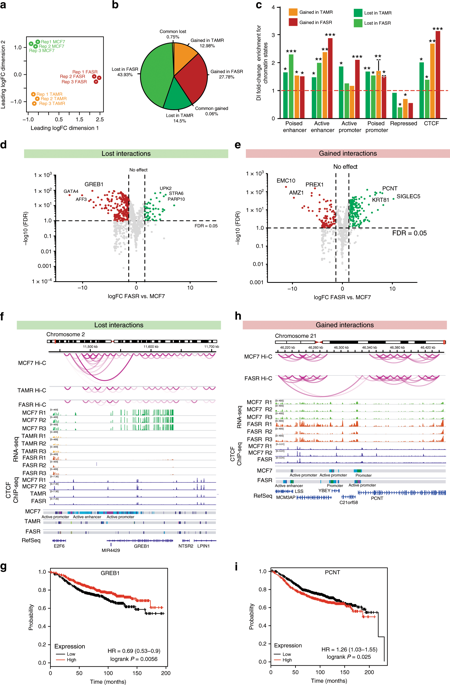当前位置:
X-MOL 学术
›
Nat. Commun.
›
论文详情
Our official English website, www.x-mol.net, welcomes your
feedback! (Note: you will need to create a separate account there.)
Epigenetic reprogramming at estrogen-receptor binding sites alters 3D chromatin landscape in endocrine-resistant breast cancer.
Nature Communications ( IF 14.7 ) Pub Date : 2020-01-16 , DOI: 10.1038/s41467-019-14098-x Joanna Achinger-Kawecka 1, 2 , Fatima Valdes-Mora 1, 2 , Phuc-Loi Luu 1, 2 , Katherine A Giles 1 , C Elizabeth Caldon 3 , Wenjia Qu 1 , Shalima Nair 1 , Sebastian Soto 1 , Warwick J Locke 1 , Nicole S Yeo-Teh 1 , Cathryn M Gould 1 , Qian Du 1 , Grady C Smith 1 , Irene R Ramos 4 , Kristine F Fernandez 3 , Dave S Hoon 4 , Julia M W Gee 5 , Clare Stirzaker 1, 2 , Susan J Clark 1, 2
Nature Communications ( IF 14.7 ) Pub Date : 2020-01-16 , DOI: 10.1038/s41467-019-14098-x Joanna Achinger-Kawecka 1, 2 , Fatima Valdes-Mora 1, 2 , Phuc-Loi Luu 1, 2 , Katherine A Giles 1 , C Elizabeth Caldon 3 , Wenjia Qu 1 , Shalima Nair 1 , Sebastian Soto 1 , Warwick J Locke 1 , Nicole S Yeo-Teh 1 , Cathryn M Gould 1 , Qian Du 1 , Grady C Smith 1 , Irene R Ramos 4 , Kristine F Fernandez 3 , Dave S Hoon 4 , Julia M W Gee 5 , Clare Stirzaker 1, 2 , Susan J Clark 1, 2
Affiliation

|
Endocrine therapy resistance frequently develops in estrogen receptor positive (ER+) breast cancer, but the underlying molecular mechanisms are largely unknown. Here, we show that 3-dimensional (3D) chromatin interactions both within and between topologically associating domains (TADs) frequently change in ER+ endocrine-resistant breast cancer cells and that the differential interactions are enriched for resistance-associated genetic variants at CTCF-bound anchors. Ectopic chromatin interactions are preferentially enriched at active enhancers and promoters and ER binding sites, and are associated with altered expression of ER-regulated genes, consistent with dynamic remodelling of ER pathways accompanying the development of endocrine resistance. We observe that loss of 3D chromatin interactions often occurs coincidently with hypermethylation and loss of ER binding. Alterations in active A and inactive B chromosomal compartments are also associated with decreased ER binding and atypical interactions and gene expression. Together, our results suggest that 3D epigenome remodelling is a key mechanism underlying endocrine resistance in ER+ breast cancer.
中文翻译:

雌激素受体结合位点的表观遗传重编程可改变内分泌抗性乳腺癌的3D染色质景观。
内分泌治疗耐药性经常在雌激素受体阳性(ER +)乳腺癌中发展,但其潜在的分子机制尚不清楚。在这里,我们显示在ER +内分泌抗性乳腺癌细胞内和拓扑关联域(TAD)内和之间的3维(3D)染色质相互作用经常发生变化,并且在CTCF结合处,抗性相关的遗传变异丰富了差异相互作用锚点。异位染色质相互作用优先在活性增强子和启动子以及ER结合位点富集,并与ER调控基因表达的改变有关,这与伴随内分泌抗性发展的ER途径的动态重塑相一致。我们观察到3D染色质相互作用的丧失通常与甲基化过高和ER结合丧失同时发生。活性A和非活性B染色体区室的改变也与ER结合减少以及非典型相互作用和基因表达有关。总之,我们的结果表明3D表观基因组重塑是ER +乳腺癌内分泌抵抗的关键机制。
更新日期:2020-01-16
中文翻译:

雌激素受体结合位点的表观遗传重编程可改变内分泌抗性乳腺癌的3D染色质景观。
内分泌治疗耐药性经常在雌激素受体阳性(ER +)乳腺癌中发展,但其潜在的分子机制尚不清楚。在这里,我们显示在ER +内分泌抗性乳腺癌细胞内和拓扑关联域(TAD)内和之间的3维(3D)染色质相互作用经常发生变化,并且在CTCF结合处,抗性相关的遗传变异丰富了差异相互作用锚点。异位染色质相互作用优先在活性增强子和启动子以及ER结合位点富集,并与ER调控基因表达的改变有关,这与伴随内分泌抗性发展的ER途径的动态重塑相一致。我们观察到3D染色质相互作用的丧失通常与甲基化过高和ER结合丧失同时发生。活性A和非活性B染色体区室的改变也与ER结合减少以及非典型相互作用和基因表达有关。总之,我们的结果表明3D表观基因组重塑是ER +乳腺癌内分泌抵抗的关键机制。











































 京公网安备 11010802027423号
京公网安备 11010802027423号